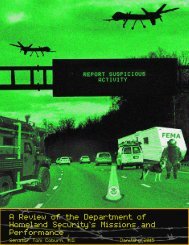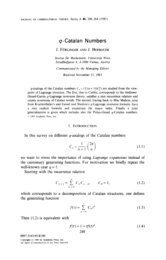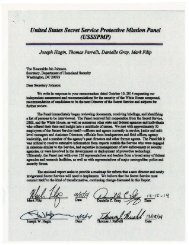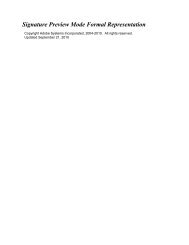14_1218_usss_pmp 2016
You also want an ePaper? Increase the reach of your titles
YUMPU automatically turns print PDFs into web optimized ePapers that Google loves.
)<br />
11<br />
,_,. , ; I ; ~,<br />
. '\, .\•<br />
United States Secret Service Protective Kusion Panel<br />
(lffSSSPMP)<br />
------ - --<br />
Joseph Hagin, Thomas Pen-elli, Danielle Gray, Mark Filip<br />
Tho Hononble Jeh Johnson.<br />
Semetary, Department of Hom.eland Security<br />
Washmgton, DC 20393<br />
Dear Secretary Johnson:<br />
We write in response to your memorandum dated October 10, 20<strong>14</strong> requesting om<br />
independent assessment and recommendations for the security of the White H01180 compound,<br />
recommendation of candidatN to be the next Director of the Secret Service and subjects for<br />
further review.<br />
The Panel jmmediately began reviewing documents, receiving briefings, ml identifying<br />
a list of penons to be interviewed. The Panel received full coopmation from tho Secret Service,<br />
DHS, and the White House, as well as numerous other state and federal agencies and indivicluala<br />
who offered their time and insight into a multitude of issues. We met with approximately SO<br />
employees of tho Secret Service i1aelf--ofticers and agents currently in service, junior ml mid·<br />
level~ and Assistant Directors, oflicials ftom headqullrten and field otJices, agency<br />
leadmbip, and a numbet of tho agency's put dimctors and other former agents. The Panel felt it<br />
wu critical to receive extensive information from expmta outside the Semce who were enpged<br />
in missions similar to the Service, had expertise in management of law en.bcement or security<br />
agencies, or were involved in the development or ~loymmt of protective teolmology.<br />
tntimately, the Panel met with over 120representativesandleaders1rom a broad array of federal<br />
agencies and reaearch facilities, as well u with repreae1 datives of nutjor metropolmm police and<br />
aecurlty forces.<br />
The enclosed report seeks to provide a roadmep for reform 1bat a new director and newly<br />
invigorated Secret Service will need to implement. We believe that the Secret Service.must<br />
commit itself to .the kind of tnmsformadve, contimdng change diacussecl in this Report.
United States Secret Service Protective Mission Panel<br />
(USSSPMP)<br />
Joseph Hagin, Thomas Perrelli, Danielle Gray, Mark Filip<br />
Executive Summary<br />
to<br />
Report from the<br />
United States Secret Service<br />
Protective Mission Panel<br />
to the<br />
Secretary of Homeland Security<br />
DECEMBER 15, 20<strong>14</strong>
This page intentionally left blank.
EXECUTIVE SUMMARY 1<br />
The paramount mission of the United States Secret Service-protecting the President and<br />
other high-ranking national officials-allows no tolerance for error. A single miscue, or even a<br />
split-second delay, could have disastrous consequences for the Nation and the world. The men<br />
and women of the Secret Service fulfill one of the most important obligations in this country, and<br />
they do so often with no personal recognition, no desire for fame, and modest compensation. We<br />
know special agents of the United States Secret Service as the silent figures around the President,<br />
but we tend to notice them only in the extraordinarily rare moments when they fail. Most<br />
Americans know little of the work of the Secret Service's Uniformed Division and do not realize<br />
that it is the Uniformed Division that plays a primary role in the protection of the White House.<br />
Throughout its work, the Protective Missions Panel (''the Panel") developed an even<br />
greater appreciation than each of us had previously for the work of the Secret Service. From our<br />
meetings at the highest levels of the Secret Service, to meetings with line agents and officers, we<br />
saw individuals who were unwavering in their passion and dedication to duty. In discussions<br />
with others inside and outside of the U.S. government, including other law enforcement agencies<br />
and the U.S. military, there was agreement that, when it comes to providing personal protection<br />
to a chief executive and others, the Secret Service is without peer. Facing constant threats and<br />
charged with guarding the world's most powerful and visible head of state and the most<br />
accessible executive mansion of any large nation, the Secret Service has an extraordinary track<br />
record of success. This is not to say that the Secret Service does not make mistakes. But we owe<br />
the agents, officers, and line personnel of the Secret Service a debt of gratitude.<br />
For an organization that has a zero-failure mission, however, a commitment to constant<br />
improvement and a refusal to compromise are essential. The Secret Service must be prepared to<br />
face every evolving threat in a rapidly changing environment and to stay constantly ahead of<br />
those who could threaten the White House, the President, and other protectees-including the<br />
First Family, the Vice-President, and foreign heads of state. That central mission requires a<br />
dynamic organization that constantly evaluates its performance and seeks to improve, with<br />
leaders able to take the agency to that higher level of performance. It requires personnel who are<br />
not only·committed to the mission and of great character and ability, but who are also highly<br />
trained and innovative. And it requires deployment of the best available technology to augment<br />
the talents and training of the men and women of the Secret Service.<br />
The Panel was established following the events of September 19, 20<strong>14</strong>, when a lone<br />
individual leapt over the White House fence, onto the North Lawn, and ultimately into the White<br />
House itself. This Panel's mandate was not to redo the report prepared by Department of<br />
Homeland Security ("DHS") Deputy Secretary Alejandro Mayorkas ("Mayorkas Report"), which<br />
makes specific findings related to the September 19 fence-jumping incident, but to accept its<br />
findings and undertake a broader review of the Secret Service's protection of the White House<br />
compound.<br />
1<br />
On December 15, the United States Secret Service Protective Mission Panel submitted its full Report to the<br />
Secretary of Homeland Security for review. This Executive Summary provides a high-level overview of our<br />
independent assessments and recommendations to the Secretary.<br />
1
The Panel enjoyed full cooperation from the Secret Service, DHS, and the White House,<br />
as well as numerous other state and federal agencies and individuals who offered their time and<br />
insight into a multitude of issues. We met with approximately 50 employees of the Secret<br />
Service itself---0fficers and agents currently in service, junior and mid-level managers and<br />
Assistant Directors, officials from headquarters and field offices, agency leadership, and a<br />
number of the agency's past directors and other former agents. The Panel thanks Acting Director<br />
Joe Clancy for this cooperation and for all that he has already done to put the Secret Service back<br />
on the right course.<br />
The Panel also felt it was critical to receive extensive information from experts outside<br />
the Service who were engaged in missions similar to the Service, had expertise in management<br />
of law enforcement or security agencies, or were involved in the development or deployment of<br />
protective technology. Ultimately, the Panel met with over 120 representatives and leaders from<br />
a broad array of federal agencies and research facilities, as well as with representatives of major<br />
metropolitan police and security forces. Among government agencies alone, in addition to<br />
Secret Service and White House personnel, the Panel met with representatives of the Central<br />
Intelligence Agency; the Defense Advanced Research Projects Agency; the Department of<br />
Defense's Joint Non-Lethal Weapons Directorate; the Defense Threat Reduction Agency; the<br />
Federal Bureau of Investigation Security Division and Washington Field Office; the Department<br />
of Homeland Security's Office of Cybersecurity and Communications, Federal Protective<br />
Service, Office of the Chief Financial Officer, Office of the General Counsel, .Office of<br />
Infrastructure Protection, Office of the Inspector General, Office of Operations, Coordination,<br />
and Planning, the Science and Technology Directorate's Homeland Security Advanced Research<br />
Projects Agency, and the Transportation Security Administration; the U.S. Marine Corps; the<br />
U.S. Marshal Service; the U.S. Navy; the U.S. Park Police; the Pentagon Force Protection<br />
Agency; Sandia National Laboratories; and the Department of State's Bureau of Diplomatic<br />
Security. The Panel also met with, among others, local law enforcement agencies that often<br />
partner with the Secret Service.<br />
Our review and recommendations fall within three general areas: training and personnel;<br />
perimeter security, technology, and operations; and leadership. A number of the<br />
recommendations go directly to issues highlighted by the events of September 19. Among other<br />
things, the Panel believes strongly that the fence around the White House needs to be changed as<br />
soon as possible to provide better protection. We recognize all of the competing considerations<br />
that may go into questions regarding the fence, but believe that protection of the President and<br />
the White House must be the higher priority. As the Executive Branch, Congress, and the<br />
Service itself have all recognized, the fence must be addressed immediately.<br />
A better fence can provide time, and time is crucial to the protective mission. Every<br />
additional second of response time provided by a fence that is more difficult to climb makes a<br />
material difference in ensuring the President's safety and protecting the symbol that is the White<br />
House. Additionally, the ease with which "pranksters" and the mentally ill can climb the current<br />
fence puts Secret Service personnel in a precarious position: When someone jumps the fence,<br />
they must decide, in a split-second, whether to use lethal force on a person who may not actually<br />
pose a viable threat to the President or the White House. By deterring these more frivolous<br />
2
threats, a more effective fence can minimize the instances when such difficult decision making is<br />
required.<br />
We decline to say precisely what the optimal new fence should look like. Importantly,<br />
designers of the new fence must balance security concerns with the long and storied tradition of<br />
the White House being the "People's House." These historical, symbolic, and aesthetic factors<br />
deserve consideration, but ultimately they should not be permitted to delay or prevent a fence<br />
that could save lives. A number of common-sense improvements should be explored. For sure,<br />
the fence must be taller; even an increase of four or five feet would be materially helpful.<br />
Horizontal bars, where climbers can easily place feet or hands, should be eliminated or placed<br />
where they provide little assistance. The top of the fence can also be manipulated in certain<br />
ways-such as including curvature outward at the top of the fence--to make scaling it much<br />
more difficult for most. Any of these adjustments, the Panel is certain, can be made without<br />
diminishing the aesthetic beauty or historic character of the White House grounds.<br />
But the problems exposed by recent events go deeper than a new fence can fix. The<br />
Panel thus looked more broadly at the Service, recognizing that issues affecting the Service's<br />
protective operations more generally have their greatest impact on protection of the White House<br />
and President. Of the many concerns the Panel encountered, the question of leadership is, in our<br />
view, the most important. The Panel found an organization starved for leadership that rewards<br />
innovation and excellence and demands accountability. From agents to officers to supervisors,<br />
we heard a common desire: More resources would help, but what we really need is leadership.<br />
Consistent with Secretary Johnson's directive, the Panel considered the qualities needed<br />
in a new director for the Service, as well as the next management team. The Panel has concluded<br />
that the Service needs strong, new leadership that can drive change within the organization.<br />
While we believe the right person could come from many different backgrounds and believe that<br />
leadership qualities are more important than any particular background, we think the right person<br />
should come from outside the Service. We know that many in the Service today would argue<br />
that its unique protective mission can only be understood and managed by someone who has<br />
served within its ranks. The Panel appreciates the virtue of experience in the Service, but we<br />
believe that at this time in the agency's history, the need for Service experience is outweighed by<br />
what the Service needs today: dynamic leadership that can move the Service forward into a new<br />
era and drive change in the organization. The next director will have to make difficult choices,<br />
identifying clear priorities for the organization and holding management accountable for any<br />
failure to achieve those priorities. Only a director from outside the Service, removed from<br />
organizational traditions and personal relationships, will be able to do the honest top-to-bottom<br />
reassessment this will require. Finally, this will also require support from a management team<br />
that combines diverse strengths-including those in the Service as well as those from outside,<br />
those with special agent or law enforcement training, and those with other professional<br />
backgrounds.<br />
The new leader will need to help the Secret Service learn to improve itself by listening to<br />
the outside. The Panel heard one common critique from those inside and outside the Service:<br />
The Service is too insular. The Secret Service is justifiably proud of its preeminence and its<br />
history. But the Secret Service could benefit greatly from reaching outside itself to other entities,<br />
3
here and abroad, that share a similar mission or have knowledge and skills that would be<br />
valuable to the Secret Service. The Panel spent significant time interviewing leaders inside and<br />
outside the federal government who are experts in technology and protection of physical<br />
locations, and the Service could benefit greatly from long-term consistent engagement with these<br />
types of complementary experts. Such engagement should include regular and hard-edged<br />
evaluations of the Service itself, as well as its methods; this kind of constant evaluation and<br />
improvement needs to become part of the Secret Service's culture.<br />
The next director also needs to help the Secret Service be clear about its priorities, and<br />
there should be no doubt about what comes first. The agency exists to protect the President and<br />
its other very high-level protectees. Yet the Secret Service has sometimes acted in ways that<br />
send mixed signals on a number of fronts. While promoting other capacities might help bring<br />
resources into the agency, the new leadership needs to think carefully about how the agency's<br />
core priorities are implemented up and down the organization, and focus on improving them.<br />
The new leader will also need to reform the Secret Service's administrative capabilities.<br />
If the Secret Service is to remain the best in the world and defeat its adversaries every time, it has<br />
to be the best in every facet of the game. An agency that needs the best agents and officers on<br />
the front lines needs a hiring process run by human resources experts valued for their specialized<br />
knowledge about how to recruit and retain talent, in a timely and efficient manner. An agency<br />
that needs to be three steps ahead of those who would do its protectees harm needs more of the<br />
best and most innovative scientists and engineers dreaming up ways to defeat the next threat.<br />
And an agency that needs to spend every penny wisely needs an administrative department that<br />
can demonstrate with rigorous precision why additional resources are necessary and knows how<br />
to budget for it.<br />
Finally, the next director will need to help strengthen a culture of accountability. The<br />
organization asks its protective agents to stand in front of a bullet to protect the President. It<br />
expects its Uniform Division officers to maintain high alertness at every moment of a long shift.<br />
It requires its advance teams to scour massive new venues for the smallest weakness. The<br />
agency's zero-failure mission requires that its high standards be met. In order for the Service's<br />
agents and officers to meet its high standards, they must see that the organization itself believes<br />
in its standards and enforces them in a consistent, evenhanded manner. In other words, agency<br />
leadership, managers, and front line supervisors must believe and show that they are accountable<br />
for their mission. These are not just morale issues, or issues of fairness or trust. Accountability<br />
creates the culture of performance that the Secret Service needs to meet its zero-failure mission.<br />
The necessary changes will thus require strong leadership, but they will also require<br />
resources. The Secret Service is stretched to and, in many cases, beyond its limits. Perhaps the<br />
Service's greatest strength-the commitment of its personnel to sacrifice and do the job "no<br />
matter what"-has had unintended consequences. Special agents and Uniformed Division<br />
personnel protecting the White House work an unsustainable number of hours. Rather than<br />
invest in systems to manage the organization more effectively and accurately predict its needs,<br />
the Service simply adds more overtime for existing personnel. Rather than sending its agents<br />
and officers to training, it keeps them at their posts.<br />
4
The Panel found that, due in large part to limitations on personnel, the Service's training<br />
regimen has diminished far below acceptable levels. The Presidential Protective Division's<br />
("PPD") so-called "Fourth Shift" had once ensured that for two weeks out of every eight, the<br />
President's detail was maintaining its strength, practicing, and getting better. But Secret Service<br />
reports show that in FY 2013, apart from firearms re-qualifications and basic career development<br />
technical requirements, the average special agent received only forty-two hours of training. The<br />
Uniformed Division has never trained at the level of PPD, but today training for the Uniformed<br />
Division has also fallen below acceptable levels. In FY 2013, Service data shows that the<br />
Uniformed Division as a whole received 576 hours of training, or about 25 minutes for each of<br />
over 1300 Uniformed Division officers. We believe that the Secret Service should be staffed at a<br />
level that enables it to provide a true Fourth Shift for training to its Presidential Protective<br />
Division and Vice-Presidential Protective Division special agents, and to ensure that Uniformed<br />
Division officers are in training for no less than 10% of their time.<br />
Providing more time for training requires increased staffing, but the Secret Service needs<br />
more agents and officers even beyond the levels required to allow for in-service training. The<br />
President and other protectees cannot receive the best possible protection when agents and<br />
officers are deployed for longer and longer hours with fewer and fewer days off. For years, the<br />
Service has taken on additional missions-in both its protective and investigative roles--but has<br />
not matched its request for additional resources to those expanded missions. The Service has to<br />
increase the number of agents and, to an even greater extent, increase the size of the Uniformed<br />
Division to ensure protection of the White House. We think that a new director should give<br />
serious consideration to whether there are collateral or non-essential missions that can be shed,<br />
though we believe the Service's investigative mission provides benefits to its protective mission.<br />
We also recognize that the new director must carefully manage the Service's other missions to<br />
ensure adequate resources are available to protection. But under any scenario, the Service has to<br />
increase significantly in size.<br />
This Report attempts to quant_ify the additional personnel needed, but the Panel has been<br />
hamstrung to some extent by the lack of complete data. Put simply, the Service does not have<br />
systems in place to make the most prudent budgeting choices. Like so many agencies, the /<br />
Service has, for years, looked at its base budget and tried to ballpark how much more it might be<br />
able to get through the OMB and congressional processes. The result, however, is that no one<br />
has really looked at how much the mission, done right, actually costs. That is why one of our<br />
most important recommendations is that a new director start with a zero-based budget. Forget<br />
about what the Service has asked for in the past: Define the mission, and make the argument to<br />
policy makers in the Executive Branch and Congress that this sum-which we believe to be<br />
more than current appropriations-is needed. As an interim step, the Panel recommends that<br />
Congress and the Executive Branch work together to ensure appropriations sufficient for an<br />
additional 85 special agents and 200 Uniformed Division officers; the Panel believes this is a<br />
first step, but likely not the last step, to ensure adequate training and personnel for the White<br />
House.<br />
The Panel also reviewed a variety of physical security and operational issues at the White<br />
House, and makes a number of recommendations about the ongoing security of the compound.<br />
Aspects of this discussion are classified, and the Panel believes strongly that operational issues<br />
5
elated to the protection of the White House should not be the subject of detailed public debate in<br />
this Report or any other fora. The events of September 19 highlighted a number of potential<br />
vulnerabilities that need to be addressed quickly. Fortunately, those events have served as a call<br />
to action for the Service.<br />
* * *<br />
Many of the recommendations set forth below are not new. Indeed, some of them<br />
precisely echo recommendations that the White House Security Review made in 1995 ("1995<br />
Security Review") but that remain concerns today. Others even harken back to<br />
recommendations made in the Warren Commission Report following the assassination of<br />
President Kennedy. And still others track internal recommendations made by the Service. As<br />
the Secret Service itself has recognized, the Service has often made recommendations and<br />
proposed solutions as it identified problems, but has frequently failed to implement its own<br />
recommendations.<br />
Some of the changes address isolated problems, with well-defined options to solve them,<br />
while others will require far more study by, we hope, a dynamic, new management team that will<br />
lead the Service into the future. Following September 19, the Service began implementing a<br />
number of reforms, and those efforts have continued alongside the Panel's work.<br />
Finally, the Panel recognizes that many of these recommendations will be difficult.<br />
Many will cost money, which is always a challenge in Washington D.C. We are mindful of the<br />
current budget climate and the value of taxpayer dollars, and we would not recommend spending<br />
a penny unwisely.<br />
Many others will require strong leadership and a will to change, which can be difficult for<br />
an organization with such a storied history. Some in the Secret Service will resist and may need<br />
to move on. But the Secret Service cannot lose focus on its core and essential mission: the<br />
protection of the current, past, and future Presidents of the United States. As a nation, we should<br />
not fail to make prudent investments in personnel, technology, and leadership when the stakes<br />
are so high.<br />
6
Summary of Recommendations<br />
Training and Personnel<br />
> Provide a true "Fourth Shift" for training the Presidential and Vice-Presidential Protective<br />
Divisions, so that they spend two weeks out of every eight in training, and ensure that<br />
Uniformed Division ("UD") officers are in training for no less than 10% of their time: Only<br />
with constant training can all of the teams at the White House perform the coordinated actions needed<br />
to effectively respond.<br />
> Implement integrated training focused on ensuring that all teams at the White House know<br />
their roles in responding to specific threats: Teams need to train with the full complement of<br />
forces with which they will operate in real life, and the training needs to be provided force-wide, not<br />
just to those on duty on the day that training is scheduled.<br />
> Train in conditions that replicate tbe physical environment in which they will operate: A<br />
security team should also be trained so that it is intimately familiar with the space in which it is<br />
operating.<br />
> Increase the Uniformed Division, as guickly as can be appropriately managed, by an initial 200<br />
positions, and the Presidential Protective Division ("PPD") by 85 positions. Perform additional<br />
analyses and, likely, further increases as necessary: Both UD and PPD are currently stretched<br />
beyond their limits.<br />
> Reform and professionalize recruiting. hiring, promotion and rotation process that puts the<br />
most talented, capable individuals in place as efficiently as possible: The Service must continue<br />
efforts to develop a professionalized recruiting and hiring process that finds talented individuals,<br />
evaluates candidates rigorously for the PPD, and hires them quickly.<br />
Technology, Perimeter Security, and Operation;<br />
> Ensure that the Office of Technical Development and Mission Support proactively reviews and<br />
refreshes the Service's technological footprint. The Service should receive dedicated fu11ds for<br />
technology, both within its own budget and within DHS Science & Technology's budget, to<br />
accomplish these tasks: Technology systems used on the complex must always remain on the<br />
cutting edge, and the Service must invest in technology, including becoming a driver ofresearch and<br />
development that may assist in its mission.<br />
> Replace the outer fence that surrounds the 18 Acres to give Secret Service personnel more time<br />
to react to intrusions: The current seven-and-a-half-foot fence, not just along Pennsylvania Avenue<br />
but around the compound's entire perimeter, must be replaced as quickly as possible.<br />
Leadership<br />
> Clearly communicate agency priorities, give effect to those priorities through its actions, and<br />
align its operations with its priorities: The Panel believes the Secret Service's leadership must<br />
make those choices in a manner to ensure that its core protective mission remains first priority.<br />
> Promote specialized exoemse in its budget, workforce, and technology functions. Filling<br />
important administrative functions with agents rather than professional administrators may<br />
not be optimal.<br />
2<br />
A number of our recommendations pertaining to technology, perimeter security, and operations contained<br />
classified material and are thus not reproduced here.<br />
7
~ Present a zer«>-based or mission-based budget that will provide sufficient resources to<br />
accomplish its mission, beginning immediately by worldng within DBS to adopt a workforce<br />
staffing model: The Service must build a new budget from the ground up by defining its mission,<br />
determining what it will take to achieve it, and asking for that. The mission is important enough to<br />
justify that approach.<br />
~ Create more opportunities for officers and agents to provide input on their mission and train its<br />
mid- and lower-level managers to encourage, value and respond to such feedback: Leadership<br />
and, even more critically, mid- and lower-level managers, need to make clear that their mission<br />
requires that they get things right-and thus that the agency values information out of sync with the<br />
status quo or the leadership's views.<br />
~ Lead the federal protective force community: Collaboration with protective forces like the Federal<br />
Protective Service, the Pentagon Force Protection Agency, the FBI Police, and the State Department's<br />
Bureau of Diplomatic Security and other agencies, especially on technology, could significantly<br />
increase opportunities for innovation.<br />
~ Receive periodic, outside assessments of the threats to and strategies for protecting the White<br />
House compound: The Secret Service should engage other federal agencies to evaluate the threats<br />
that the agency faces and its ways of doing business.<br />
~ Resume participation in international fora with comparable protective services of friendly<br />
nations: While most national protective forces do not compare to the Secret Service, those of certain<br />
nations are much more similar than they are different.<br />
~ Give leadership's priorities and reforms the organization's sustained attention and hold the<br />
agency accountable through to their completion: Following through on reforms and<br />
recommendations has been an issue for the Service in the past.<br />
~ Implement a disciplinary system in a consistent manner ~hat demonstrates zero tolerance for<br />
failures that are incompatible with its zer«>-failure mission: It is clear that the rank-and-file-and<br />
even very senior current and former members of the Secret Service-do not have confidence that<br />
discipline is imposed in a fair and consistent manner.<br />
~ Hold forces accountable for performance by using front-line supervisors to constantly test<br />
readiness: To be ready for a job where quick reactions and reflexes are critical, supervisors need to<br />
drive home to their officers and agents that the front line is constantly being tested.<br />
~ The next director of the Secret Service should be a strong leader from outside the agency who<br />
has a protective, law enforcement, or military background and who can drive cultural change<br />
in the organization and move the Secret Service forward into a new era: The need to change,<br />
reinvigorate, and question long-held assumptions-from within the agency itself-is too critical right<br />
now for the next director to be an insider.<br />
~ Establish a leadership development system that identifies and trains the agency's future<br />
managers and leaders: To promote from within and move the agency forward, however, the Secret<br />
Service needs to do a better job of identifying future leaders and preparing them for the role.<br />
8









![55721335-d6fe09eb5ffdcc87dbf6c3f0b5bbda07d2261e98[1]](https://img.yumpu.com/56533583/1/186x260/55721335-d6fe09eb5ffdcc87dbf6c3f0b5bbda07d2261e981.jpg?quality=85)








